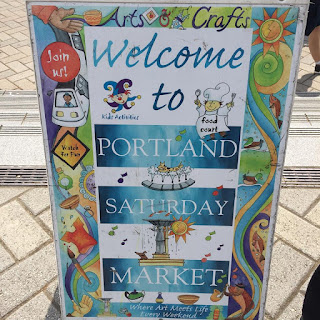It is one of my life's joys that I get to work at Spring Market, a trade show that is open to the trade, not the public. The Spring Market moves around the country, while Fall Market is always in Houston, the week before Festival. Last year Spring Market was in St. Louis, next year it will be in Kansas City.
Shop owners come from all over the world to meet with fabric companies, publishers, pattern designers, sewing machine companies and many more vendors who are all part of this $3.75 billion dollar industry. I enjoy seeing some of my favorite people at Market.
Here is just a taste of my trip to Market:
Set up day is chaotic on the show floor but it is always ready to open on time:
There is a lot of art in the Oregon Convention Center:
My very favorite is this Foucault Pendulum, the coolest non-quilt thing at the show. My university had one of these in the Science Building so it always takes me back to see this:
The Oregon Convention Center is a LEEDS certified building, meaning they have worked very hard to reuse and recycle things and reduce their carbon footprint. There are several large wall displays that explain how they do that. Here is a fun display:
The view of the convention center from a nice restaurant on the top of a nearby hotel. The restaurant is called Altabira. I recommend reservations:
At Schoolhouse vendors show what is new in 30 minute mini-classes. A quilt I participated in making was unveiled by StudioE, using Peppered Cottons, wonderful shot cottons that are a delight to work with. My block is in the lower right:
Great fabrics are unveiled as they are now available for shops to order for future delivery:
 |
| Patrick Lose |
 |
| Gypsy by Jessica VanDenburgh for Windham Fabrics |
 |
| Gypsy |
 |
| Road Trip by Allison Glass for Andover |
 |
| Metropolis by MODA |
 |
| Metropolis by MODA |
Occasionally we get a little time to get out of the building and explore. We hoped on the light rail and went to Saturday Market, where there are lots of arts and crafts things for sale, many food trucks with many different kinds of food, and lots of people. It was a sunny day and everyone was having a good time:
This guy stood completely still for long periods then would move unexpectedly:
Kids always have fun:
All too soon we pack up and it's time to go home. Here is just a small portion of the Education Office crates being readied for return shipment to Houston. Each crate is numbered, inventoried, and sorted by which of 3 locations they will be shipped to, then palletized and headed out for shipment. It takes a good bit of time to do this right but we've got it down to a science now. After 20 years I am still impressed with the way this all works:
I flew from Portland to Detroit and was amazed by this lightshow in the tunnel from one Terminal to the next. It did change to bright red while I was on the walking sidewalk but I didn't stop to capture that:
My goodies. I almost always buy thread and this time I got some great fabrics too. And tote bags, we always get tote bags:
Now it's time to get back to work. Several tasks have to get done today and tomorrow--first up was laundry: check, all done.
You can find thousands of images on Facebook and Instagram, among other social media, #quiltmarket, if you want to see lots more of what happens there.
Let's quilt!
Barbara


























































